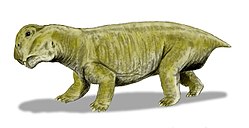| Lystrosauridae | |
|---|---|
 | |
| Life restoration of Lystrosaurus georgi | |
| Scientific classification | |
| Kingdom: | Animalia |
| Phylum: | Chordata |
| Clade: | Synapsida |
| Clade: | Therapsida |
| Clade: | † Anomodontia |
| Clade: | † Dicynodontia |
| Infraorder: | † Dicynodontoidea |
| Family: | † Lystrosauridae Broom, 1903 |
| Genera | |
| |
Lystrosauridae is a family of dicynodont therapsids from the Permian and Triassic time periods. It includes two genera, Lystrosaurus and Kwazulusaurus . [7] Kwazulusaurus includes a single species, K. shakai, from the Late Permian of South Africa [8] and Lystrosaurus includes many species from the Late Permian and Early Triassic of South Africa, India, and Antarctica. [1]





